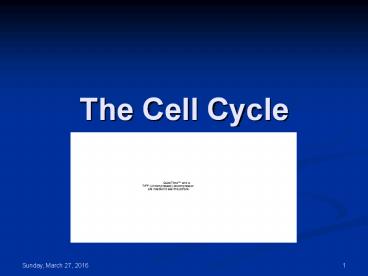The Cell Cycle - PowerPoint PPT Presentation
1 / 28
Title:
The Cell Cycle
Description:
Title: Genetics Part 1 Vocabulary Author: Ryan Barrow Last modified by: Blanche Ely High School Created Date: 10/6/2005 2:21:49 AM Document presentation format – PowerPoint PPT presentation
Number of Views:101
Avg rating:3.0/5.0
Title: The Cell Cycle
1
The Cell Cycle
2
Genetics Part 1The Cell CycleVocabulary
- Reproduction
- Involves the creation of new individuals
- Cell Theory Revisited
- Cells arise from preexisting cells
- Sexual Reproduction (Sex)
- Involves the combining of genes from two
different individuals into new arrangements - Genes are arranged (sorted) into new arrangements.
3
Vocabulary II
- Asexual Reproduction
- Sex without the sorting of genes
- Example--when an amoeba divides
- Involves the production of a new organism of
species from a cell or cells of a single parent. - Cell Cycle
- An ordered sequence of events in the life of a
dividing eukaryotic cell.
4
Vocabulary III
- Homework Assignment
- Define Budding and list an example/examples of
where budding occurs. - Define Fission and list an example/examples of
where fission occurs.
5
Vocabulary III
- Chromosome
- A linear end to end arrangement of genes and
other DNA - Chromosome set
- Total number of chromosomes in the chromosome set
- Represented by the letter n
- Chromatid
- One of the two side-by-side replicas produced by
chromosome division - Centromere
- Place where chromatids are held together
6
Vocabulary IV
- Haploid
- A cell having one chromosome set
- Human Sperm 1 set of 23 chromosomes
- Female Egg 1 set of 23 chromosomes
- In human sex cells n, we represent the chromosome
set by n - Diploid
- A cell having 2 chromosome sets
- As an individual, your somatic cells contain 46
chromosomes (23 23) - In human somatic cells, we represent the sets by
2n (2 23 chromosomes) - Your sex cells still have 1 set of 23 chromosomes
7
(No Transcript)
8
Mitosis
- Precise duplication of the contents of the parent
cell nucleus, followed by an orderly separation
of those contents into two new, identical nuclei. - Mitosis is asexual reproduction
- Occurs in somatic cells
- Produces 2 daughter cells from each/one parent
cell
9
Cell Cycle Picture 1Three Stages
- Interphase
- G1 phase
- Gap phase 1
- S phase
- DNA synthesis
- DNA is duplicated
- We will cover this after Mitosis and Meiosis
- G2 phase
- Gap Phase 2
- M phase
- Mitotic phase
- PMAT
- Cytokensis
10
(No Transcript)
11
(No Transcript)
12
Cell CycleStep by Step
- Interphase
- Accounts for about 90 of the cell cycle
- Cell grows and and copies its chromosomes in
preparation for cell division - G1, S and G2 phase occur
13
Cell CycleMitotic Phase (Mitosis)
- Prophase
- Longest of mitotic phase
- Chromosomes condense and become visible
- Chromosomes, once duplicated, are called two
sister chromatids - Two chromatids (sister chromatids) are formed by
one chromosome - Mitotic spindle assembles
14
Prophase
15
Prophase
16
Metaphase
- Chromosomes align along the middle (equatorial
plane) of the cell - Microtubules attach chromosomes to opposite ends
of the spindle
17
Metaphase
18
Metaphase
19
Cell CycleMitosis
- Anaphase
- Chromosomes are pulled to the poles of the cell
- Sister chromatids are separated
- Centromeres divide
- Telophase
- Nuclei (nucleus) and, nuclear envelope, reforms
in daughter cells
20
Anaphase
21
Telophase
22
Cell Cycle
- Cytokinesis
- Both daughter cells are separated and two
distinctive cells are formed. - Daughter cells are pinched off from each other
23
(No Transcript)
24
Mitosis Steps
25
(No Transcript)
26
Mitosis Final Notes
- One cell division resulting in two daughter cells
- Chromosome number, per nucleus, remains the same
- Haploid results in haploid
- Diploid results in diploid
- No crossing over
- More on this in meiosis
27
Apoptosis
- Programmed cell death
- Cell shrinks and condenses
- Nuclear envelope disassembles
- Nuclear DNA is broken up into fragments
- Teacher notes
- Gene turned on, suicide proteins are made, chain
of events occur where key proteins in cell is
broken down--suicide process regulated by
surrounding cells in the area to ensure that
cells survive only when and where they are needed.
28
CancerExtra Credit
- Proliferation genes (gas) that promote cell
division - Anti-proliferation genes (brakes) that apply the
brakes of cell division - Mutation in the proliferation genes, the genes
that promote cell division, causes the cell to
divide non-stop--hence a cancer growth or tumor
is formed































